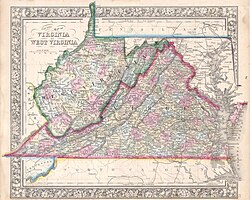Restored Government of Virginia
| Restored Government of Virginia | ||||||
| Restored state government of United States of America | ||||||
|
||||||
|
||||||
| 1864 map of the states of West Virginia and Virginia by Samuel Augustus Mitchell. The Restored Government of Virginia claimed to be the rightful government of these lands until the admission of West Virginia into the Union in 1863, after which claiming the control of the modern state of Virginia. | ||||||
| Capital |
|
|||||
| Government | Organized incorporated state | |||||
| Governor | ||||||
| • | 1861–1865 | Francis Harrison Pierpont | ||||
| Historical era | American Civil War | |||||
| • | Second Wheeling Convention | June 11, 1861 | ||||
| • | Formation of a new state government | June 19, 1861 | ||||
| • | West Virginia admitted to the Union | June 20, 1863 | ||||
| • | Surrender of the Confederacy | April 9, 1865 | ||||
| • | Provisional government formed in Richmond | May 9, 1865 | ||||
The Restored Government of Virginia, also known as the Reorganized Government of Virginia, was the Unionist government of Virginia during the American Civil War. From 1861 until mid-1863 it met in Wheeling, and from August 26, 1863 until June 1865 it met in Alexandria. The Restored Government claimed Richmond as its official capital from its formation and it moved there after the city returned to Union control.
The Restored Government had only executive and legislative branches; it did not form a judicial branch.
When the Second Wheeling Convention met in its first session, in June 1861, it adopted "A Declaration of the People of Virginia". The declaration stated that the Virginia Declaration of Rights required any substantial change in the form or nature of state government to be approved by the people. Since the Virginia secession convention had been convened by the legislature, not the people, the declaration pronounced the secession convention illegal, and that all of its acts—including the Ordinance of Secession—were ipso facto void. It also declared the pro-secession government void and called for a reorganization of the state government, taking the line that all state officials who had acceded to the Ordinance of Secession had effectively vacated their offices. The members and officers of the Restored Government had themselves not been elected by the people to the offices they had assumed, but instead convened on the basis of local petition and other irregular accreditation, some "more or less self-appointed".
The convention then elected Francis Harrison Pierpont as governor, along with other executive officers, with Wheeling as the provisional state capital. President Abraham Lincoln recognized the Restored Government as the legitimate government of the entire Commonwealth of Virginia. The United States Congress seated the two new United States senators chosen by its legislature, and five U.S. representatives elected from the territories that remained loyal to the Union. Its Congressional delegation in the 37th United States Congress entirely made up of Unconditional Unionists. U.S. Senators elected were Waitman T. Willey and John S. Carlile. Representatives were seated from where delegates in the Richmond Convention of 1861 had voted to remain in the Union. They were the western 10th, William G. Brown, the 11th, Jacob B. Blair, and 12th, Kellian V. Whaley, in Congressional Districts of counties that would mostly become West Virginia, along with the 7th, Charles H. Upton, from Alexandria and Fairfax County, and the 1st, Joseph E. Segar in the Eastern Shore and Tidewater Peninsulas. Following the loss of its governance over the population of West Virginia, Congress in the 38th United States Congress did not seat either Senators elected by the Restored General Assembly, nor Representatives elected in truncated elections in Union occupied areas of Virginia; the entire state's delegation went vacant.
...
Wikipedia



